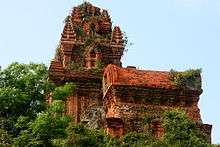Vijaya (Champa)
Vijaya was a city-state in the ancient kingdom of Champa in what is now the South Central Coast region of Vietnam. It was the capital of Champa for several centuries until it was conquered by Vietnam in 1471.
Geography, economy, transport
Vijaya was centred on the lowland area along lower Côn River, in what is now the south of Bình Định Province. To the east of the plain and near the estuary of the river is a strategic and well-protected location for a port. This led to the rise of Cảng Thị Nại, one of the major ports of Champa. The river leading up into the highlands to the west was important for the trade with highland peoples supplying Champa with luxury goods such as eaglewood for export. Vijaya's geography was also important for its agriculture. With one of the larger rivers of Champa, its soils were more fertile than that of many other places.[1] This allowed for a relatively large concentration of people near the centre of Vijaya, which resulted in a relatively large number of temples.
History
The area around Vijaya was probably one of earliest landfalls of the Cham people in what is now Vietnam.[2] However, its architecture implies that it did not become important until the 11th or 12th century.[2] Records suggest that there was an attack on Vijaya's citadel from Vietnam in 1069 (when Vietnam was ruled by Lý Nhân Tông) to punish Champa for armed raiding in Vietnam. The Cham king Rudravarman III was defeated and captured and offered Champa's three northern provinces to Vietnam (present-day Quảng Bình and Quảng Trị provinces).[3]:62,186[4]
Vijaya was also involved in wars with Angkor (now Cambodia) in the 12th and 13th centuries. Khmer military incursions into Champa were successful for some time and Suryavarman II managed to subdue Vijaya in the 1145, deposing Jaya Indravarman III,[3]:75–76 but the Khmer were later defeated in 1149.[5]:160[6] Vijaya was at times dominated by the Khmer king Jayavarman VII.[7] The Khmer king relied on Cham supporters for his successful military campaigns in both Angkor and Champa.[7] Major wars with Vietnam were fought again in the 15th century, which eventually led to the defeat of Vijaya and the demise of Champa in 1471.[8] The citadel of Vijaya was besieged for one month in 1403 when the Vietnamese troops had to withdraw because of a shortage of food.[9] The final attack came in early 1471 after almost 70 years without major military confrontation between Champa and Vietnam. It is interpreted to have been a reaction to Champa asking China for reinforcements to attack Vietnam.[10] Although much of Champa was dissolved after 1471, Vijaya, as well as other principalities, remained as a sort of protectorate within Vietnam.[11]
Architecture
Vijaya's architecture distinguishes it from other Champa centers, because it used a combination of stone and brick elements,[12] while most other Cham structures only used bricks. This suggests some influence from Cambodian Angkor.[12] It also points to the relative abundance of labour in Vijaya compared to other Champa centres of powers, because processing stones for construction was more labour-intensive than the production of bricks.[1] Vijaya's style of architecture seems to have been dominant throughout Champa for some time, given the later classification of the architecture from the period between the 12th and 14th centuries as the 'Binh Dinh style'.[13]
Remains

A relatively large number of towers built in Vijaya have been preserved in Bình Định Province. They include the ruins of the citadel: Cánh Tiên tower and several temple towers. The Dương Long towers are among Southeast Asia's tallest Hinduist buildings.[1]
The ruins of Tây Sơn era Hoang De citadel lies within the old Champa city walls.
| Site | Date[14] | Location |
|---|---|---|
| Dương Long | late 12th - early 13th century; improved up to 14th - 15th century (before 1471) | Bình Hoà, Tây Sơn |
| Hưng Thạnh / Tháp Đôi | late 12th - early 13th century | Đống Đa, Quy Nhơn |
| Cánh Tiên | late 13th - 14th/15th century | Nhơn Hậu, An Nhơn |
| Thốc Lốc / Phú Lốc | late 13th - 14th century | Bình Nghi, Tây Sơn |
| Thủ Thiện | late 13th - 14th century | Bình Nghi, Tây Sơn |
| Bình Lâm | early 11th century (c. 1000) | Phước Hoà, Tuy Phước |
| Bánh Ít / Tháp Bạc | early 11th century (c. 1000); improved later | Phước Hiệp, Tuy Phước |
References
- Tran 2009, 173
- Vickery 2009, p. 47
- Maspero, G., 2002, The Champa Kingdom, Bangkok: White Lotus Co., Ltd., ISBN 9747534991
- Nguyen 2009, p. 65
- Coedès, George (1968). Walter F. Vella (ed.). The Indianized States of Southeast Asia. trans.Susan Brown Cowing. University of Hawaii Press. ISBN 978-0-8248-0368-1.
- Vickery 2009, p. 53
- Vickery 2009, p. 54
- Vickery 2009, p. 69
- Nguyen 2009, p. 68
- Nguyen 2009, 69
- Hardy 2009, p. 119
- Vickery 2009, p. 48
- Tran 2009, p. 179
- estimates by Trần Kỳ Phương (Tran 2009, 182)
- Bibliography
- Hardy, Andrew (2009): "Eaglewood and the Economic History of Champa and Central Vietnam". in Hardy, Andrew et al. (ed): Champa and the Archaeology of Mỹ Sơn (Vietnam). NUS Press, Singapore
- Nguyễn Đình Đầu (2009): "The Vietnamese Southward Expansion, as Viewed Through the Histories". in Hardy, Andrew et al. (ed): Champa and the Archaeology of Mỹ Sơn (Vietnam). NUS Press, Singapore
- Trần Kỳ Phương (2009): "The Architecture of the Temple-Towers of Ancient Champa". in Hardy, Andrew et al. (ed): Champa and the Archaeology of Mỹ Sơn (Vietnam). NUS Press, Singapore
- Vickery, Michael (2009): "A Short History of Champa". in Hardy, Andrew et al. (ed): Champa and the Archaeology of Mỹ Sơn (Vietnam). NUS Press, Singapore